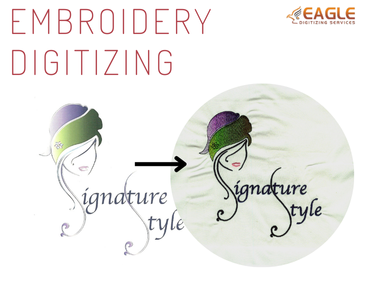Troubleshooting Common Digitizing Issues: Solutions for Seamless Embroidery
Embroidery digitizing is a meticulous craft that requires precision and attention to detail. From converting artwork into stitch files to ensuring smooth execution on the embroidery machine, every step of the digitizing process plays a crucial role in the outcome. However, even the most experienced digitizers encounter challenges along the way. In this blog, we'll delve into some common digitizing issues such as thread breakage, puckering, and distortion, and provide troubleshooting tips to help you achieve flawless embroidery designs.
Understanding Common Digitizing Issues
1. Thread Breakage
Thread breakage is a frustrating issue that can disrupt the embroidery process and result in incomplete or flawed designs. Several factors can contribute to thread breakage, including:
● Tension: Incorrect tension settings on the embroidery machine or within the digitized design can cause excessive stress on the thread, leading to breakage. Ensure that the tension settings are properly adjusted according to the type of thread and fabric being used.
● Needle Size: Using the wrong needle size for the thread or fabric can cause friction and resistance, leading to thread breakage. Choose the appropriate needle size based on the thread weight and fabric thickness to minimize breakage.
● Thread Quality: Poor-quality or old thread can be prone to breakage due to weakness or brittleness. Invest in high-quality embroidery thread from reputable manufacturers to ensure durability and reliability.
To troubleshoot thread breakage issues, start by checking the tension settings, needle size, and thread quality. Make adjustments as necessary and test the design on scrap fabric before proceeding with the final embroidery.
2. Puckering
Puckering occurs when the fabric becomes distorted or wrinkled during the embroidery process, resulting in an uneven or unsightly finish. Common causes of puckering include:
● Hooping Technique: Improper hooping techniques, such as stretching or distorting the fabric, can lead to uneven tension and puckering. Ensure that the fabric is hooped securely and evenly to prevent distortion.
● Stabilizer Selection: Using the wrong type or weight of stabilizer for the fabric can contribute to puckering. Choose a stabilizer that provides adequate support and stability for the specific fabric and design.
● Design Density: Excessive stitch density or overly dense fill areas can strain the fabric, causing puckering. Adjust the stitch density or use lighter fill patterns to reduce tension on the fabric.
Pay attention to the hooping technique, stabilizer selection, and design density to minimize puckering. Experiment with different settings and materials to find the optimal combination for your embroidery project.
3. Distortion
Distortion occurs when the embroidered design deviates from its original dimensions or shape, resulting in misalignment or irregularities. Common causes of distortion include:
● Design Scaling: Scaling the design up or down without adjusting the stitch settings can cause distortion. Ensure that the design is scaled proportionally to maintain the integrity of the stitches.
● Pull Compensation: Insufficient or excessive pull compensation settings can lead to distortion, especially in areas with tight curves or intricate details. Adjust the pull compensation settings to match the fabric and design requirements.
● Stitch Direction: Incorrect stitch direction or sequencing can cause distortion, particularly in complex designs with overlapping elements. Pay attention to the stitch order and direction to minimize distortion.
To address distortion issues, carefully review the design settings, including scaling, pull compensation, and stitch direction. Make adjustments as needed to ensure accurate replication of the original artwork.
Conclusion
Embroidery digitizing is a skillful art that requires patience, practice, and attention to detail. By understanding common digitizing issues such as thread breakage, puckering, and distortion, you can troubleshoot problems effectively and achieve flawless embroidery designs. Experiment with different settings, materials, and techniques to find the optimal combination for your specific project. With diligent practice and perseverance, you'll master the art of embroidery digitizing and create stunning designs that exceed expectations.



